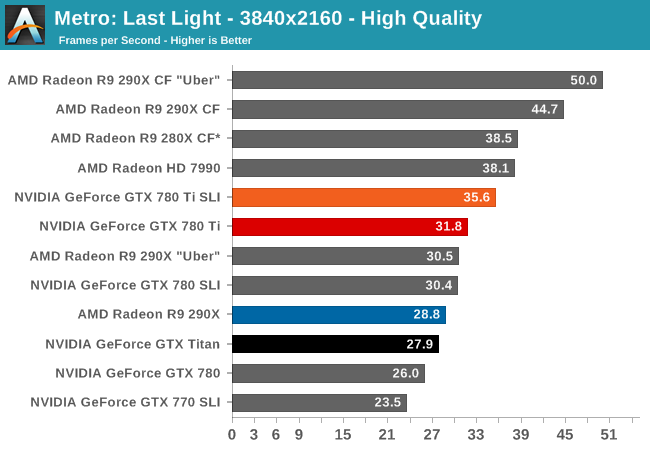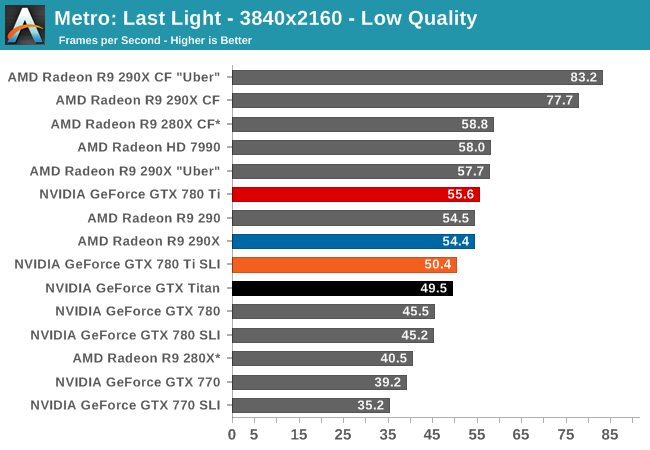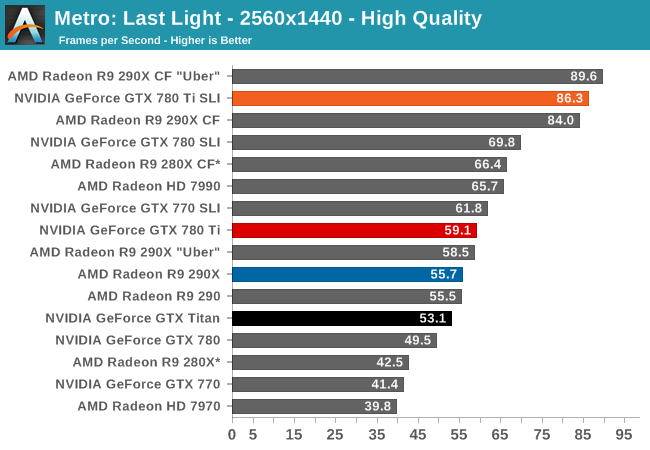The NVIDIA GeForce GTX 780 Ti Review
by Ryan Smith on November 7, 2013 9:01 AM ESTMetro: Last Light
As always, kicking off our look at performance is 4A Games’ latest entry in their Metro series of subterranean shooters, Metro: Last Light. The original Metro: 2033 was a graphically punishing game for its time and Metro: Last Light is in its own right too. On the other hand it scales well with resolution and quality settings, so it’s still playable on lower end hardware.



For the bulk of our analysis we’re going to be focusing on our 2560x1440 results, as monitors at this resolution will be what we expect a single GTX 780 Ti to be primarily used with. A single card does have the necessary horsepower to drive a 4K monitor on its own, but only at lower quality settings. Even as powerful as GTX 780 Ti is, a pair of them will be needed to get good framerates out of most games if using 4K at high quality settings.
Looking at our Metro: Last Light results then, it’s the start of what’s going to be a fairly consistent streak for the GTX 780 Ti. Though it doesn’t improve on GTX Titan or GTX 780’s gaming performance by leaps and bounds, the additional SMX and increased clockspeeds means that it has little trouble pulling away from those cards and from AMD’s 290 series. As a result the GTX 780 Ti beats the GTX Titan by 11%, GTX 780 by 19%, and though it’s closer than normal, the lead over the 290X stands at 6%.
To that end in Metro it leads the pack of single-GPU cards, though it does come up just short of being able to average 60 frames per second at 2560. Anything over 60fps will require multiple GPUs; and even then GTX 780 Ti is fast enough that sometimes even a pair of GPUs (GTX 770 SLI) isn’t going to be appreciably faster.
Meanwhile looking at GTX 780 Ti SLI performance, the SLI setup tops the charts at 2560 for everything short of the 290X in uber mode, though in this case (like most cases) two high-end GPUs is on the verge of being overkill even at 2560. Otherwise looking at 4K, NVIDIA’s poor 4K scaling on Metro once again makes itself present here, with NVIDIA’s performance only minimally benefitting from the second card. In the case of Metro at 4K, the 290X CF is going to be by far the faster option.










302 Comments
View All Comments
fewafwwaefwa - Thursday, November 7, 2013 - link
sterven.looncraz - Thursday, November 7, 2013 - link
When game producers author the games they will do it with a mind towards Mantle and exploiting the AMD GPU characteristics exposed by Mantle on PCs for their console games.When creating portable software you create as thin of an abstraction layer as possible, that layer will now be much closer to the metal with unoptimized DirectX alternatives being manually added. That could very well mean that AMD hardware will have a noticeable advantage on PCs and game producers will only need to do a little extra work to become compatible with other DX-10/11 compatible video cards on Windows/Linux - so nVidia will become something of a "don't forget about me!" rather than "let's build to a generic platform and pull in the nVidia GPU extensions..."
Basstrip - Friday, November 8, 2013 - link
I think they've ALWAYS programmed directly to the core. I think it's safe to assume that the processes translate fairly well and that although they might not be the same, they are similar.It just seems so economic to streamline the whole process. Less of a headache than to constantly try optimize things for multiple platforms.
AMD chips on consoles may not be able to support mantle on the hardware side but programming for consoles and for pc will definitely NOT be 2 completely different things.
elajt_1 - Friday, November 8, 2013 - link
Something I read on Extremetech: Feedback we’ve gotten from other sources continues to suggest that Microsoft’s low-level API for the Xbox One is extremely similar to Mantle, and the difference between the two is basically semantic. This doesn’t square very well with Microsoft’s own statements; we’ll continue to investigate.http://www.extremetech.com/gaming/168671-xbox-one-...
klmccaughey - Monday, November 11, 2013 - link
The difference is a couple of header files. Izzy Wizzy! And you have your API calling code in Xbox transferable to a PC, the header files compile the API's to Mantle API - but both API's are essentailly the same. It couldn't be easier.polaco - Friday, November 8, 2013 - link
The point of mantle I think is to provide an easy way to port from PC to console or Console to PC. So giving the possibility to allow an easier cross compilation.L33T BEANS - Friday, November 8, 2013 - link
Basing someones intelligence on a single statement is unwise.Totally - Sunday, November 10, 2013 - link
Reading these comments makes me wonder, if these people slinging mantle around like a buzzword actually know what it does, because going by the comments alone trying to pitting it against g-sync they clearly don't. Mantle is as relevant to gamers as Cuda is. Yes it does have a direct impact but the benefits aren't for the end user.klmccaughey - Monday, November 11, 2013 - link
You do not understand. The API on the consoles is basically "Mantle". Mantle copies verbatim the API calls for the consoles. They just call it the API on the console. Port the code across, change a few headers, and you have your Mantle calls ;)MonkeyM - Sunday, November 10, 2013 - link
They will sell DIY kits, you don't need a new monitor, as per the press conference.